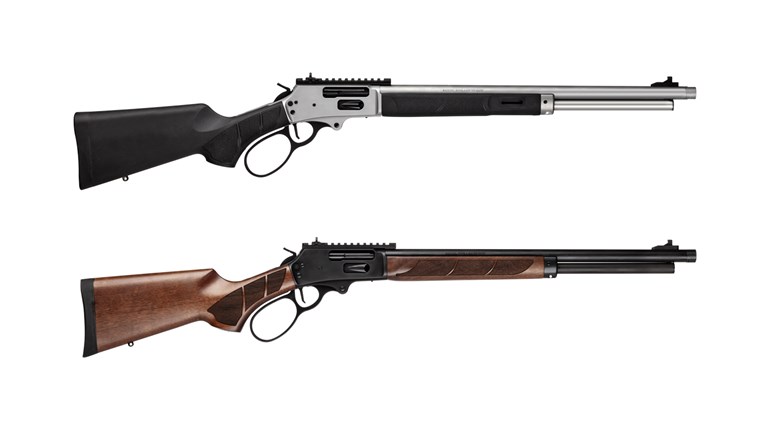
The Smith & Wesson Triple Lock paved the way for guns of different sizes and frame materials like the slightly smaller, aluminum-alloy-frame/titanium-cylinder Model 296.
Smith & Wesson’s new .44-caliber cartridge was truly special. It was 1908, and all kinds of new and different items were introduced to the gun-maker’s product lines. It was based on the super-accurate .44 Russian cartridge, but with an increase in velocity. The new round was called the .44 Spl., and it achieved a popularity all its own. At a point in history when more American fighting men found themselves practicing the martial arts, those who chose to use the revolver selected the Smith & Wesson. Was it the cartridge or the gun?
The revolver was the now-famous Smith & Wesson .44 Hand Ejector, better known as the Triple Lock. It is a large, six-shot revolver with both single- and double-action lockwork. The gun’s cylinder swings out to the left for ejection of cases. Its distinctive feature—and source of its nickname—is a special third cylinder lock. This feature is placed at the front face of the frame. The fitting of the three locks had to be done by a highly experienced gunsmith, and the legendary maker assigned the best to the job. Eventually, this unusual practice proved too expensive and the third lock was dropped. Slightly fewer than 20,000 Triple Locks were made and, if the condition is good, a surviving specimen is worth top dollar. I have looked at many gun show Triple Locks and always had the feeling that the guns have been used more than other makes and models.
Second, Third and Fourth Model .44 Hand Ejectors were made and widely used. In the first half of the 20th century, the practice of handloading ammunition became a serious part of the outdoorsman’s lifestyle, as did the process of casting bullets. The .44 Spl. was a perfect cartridge for handloading, as well as bullet casting. Also, Colt increased the options for guns by making several of its larger models in .44 Spl.—and the justly famous Single Action Army will handle the .44 Spl. easily, as will several versions of the Colt New Service, including the Shooting Master and New Service Target. The practice of shooting big-bore .44s for recreation was immensely popular with the .44 Spl. as we shut down sport shooting for World War II. When the war ended; the sportsmen came back strong, the demand for sport shooting (with handguns) was likewise strong.
The first cartridge of the “Magnum era” was the .357 Mag., introduced by Smith & Wesson in 1935. But, the gunmaker was slow to respond to the increased postwar demand, and it was well into the 1950s before we saw much in the way of shootable product. The big news was what happened to the .44 Spl. Elmer Keith had his way, and Smith & Wesson engineers stretched that .44 Spl. case a tad more and created the .44 Mag. It was a huge step forward in arms design and a great seller. Since the case was just slightly longer than the .44 Spl., it was possible to fire the shorter cartridge in the longer magnum chambers.
It cannot be overstated how strongly any mention of any item of ordnance could be identified with a single man. Keith pretty much was the .44 Mag. Fans of the revolver, cartridge and man waited breathlessly for the next mention of loading data, hunting performance or new .44-caliber bullet. The lesser recoil of .44 Spl. ammo was a major sales point for it. There was even another magnum cartridge in the .41 Mag., originating in the active imagination of Keith and primarily intended for police service. With higher-performance ammo, the .41 Mag. is scary close to the .44s.
Thus far, we have discussed the .44 Spl. as a cultural phenomenon. It was, but this is significant only as to what happened. At the end of the 20th century, Smith & Wesson was deeply involved in producing both pistols and revolvers small enough and light enough to serve as personal-defense firearms. Obviously, the guns had to deliver enough power to stop a criminal attack. The designers came up with several very appealing models, including one that was heavily dependent on the reputation of the .44 Spl.
The test sample was an aluminum-frame .44 Spl., built on a variation of the L-frame with a cylinder big enough to take five rounds of .44 Spl. The gun was light enough to carry loaded, but it was a bit large for almost all pockets. One side of the barrel bears the terse warning to use bullets no heavier than 200 grains. The standard load was 246 grains. In a gun this light, the chambers not being fired are subjected to a great deal of inertia when an adjacent chamber is fired. It may cause one or more bullets to jump their crimp and completely seize up the gun. Discontinued in 2000, the Smith & Wesson Model 296 might have been a good gun on paper, but it was not fightin’ iron.




































